We were invited to Abu Dhabi for the global first drive of the new Audi e-tron, the first series-production electric vehicle from Audi.
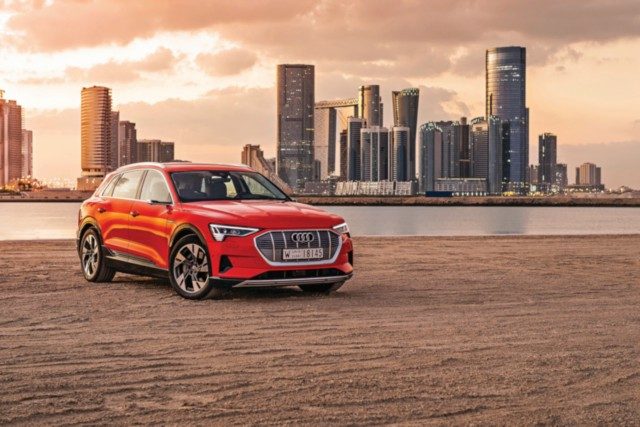
Story: Aspi Bhathena
Photography: Audi
The most animated debate nowadays is on the future of mobility; whether it should be electric or fuel cell, and electric vehicles (EV) seem to have found favour at least for the time being, for most manufacturers seem to be busy launching their versions of EV. A couple of manufacturers have already launched their electric cars and the latest to join the fray are Audi with the e-tron.
The Audi e-tron reflects the fundamentals of Audi design being translated into the electric age by new, stylistically defining details. Typically for one of the brand’s SUV models, the Audi e-tron bears the octagonal-design single-frame grille with vertical struts. Its corpus is largely enclosed and presented in platinum grey — identifying it as a fully electric model. At the lower edge of the Matrix LED headlights, four horizontal struts create the e-tron-specific signature in the daytime running lights. For the first time this is integrated directly into the headlights. The expressive design of the sill area with the black inserts visualizes the location of the battery and thus the energy centre of the Audi e-tron. At the rear, slats in the wide diffuser call attention to the omission of exhaust pipes. The e-tron logo on the charging flap and, optionally, the brake calipers stands out in the high-voltage signal colour, orange.
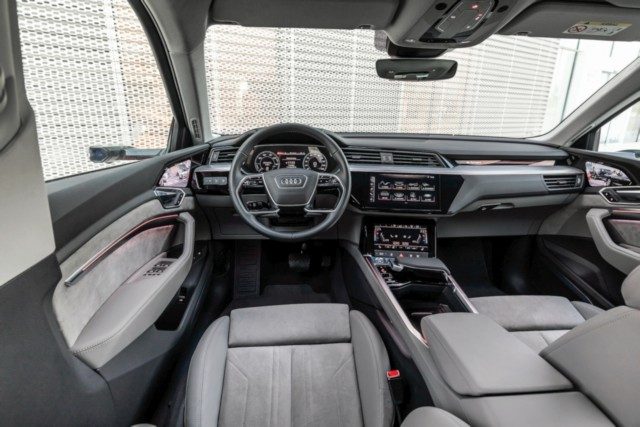
Colourful accents are also available for the spacious and airy interior, whose design embodies performance, intelligence, and lightness. The large arc into which the virtual exterior mirrors are harmoniously integrated stretches across the expansive instrument panel to the sculpted door trims, taking in-car digitalization to a whole new level.
Externally, the size of the Audi e-tron is in between the Q5 and the Q7 and it has proper tyres unlike other EV that are fitted with skinny tyres for efficiency. The front grille and the absence of exhaust tail-pipes proclaim that it is an EV.
The centre tunnel console rests on open side-walls. Seemingly floating above it is the hand-rest with integrated shifter, which the driver operates with thumb and forefinger. Lightness and performance are fused into one. Audi Media Center touchscreen occupies the entire driver’s area and has a driver-centred bias. The two large MMI touch response displays, too, are angled in the driver’s direction. They replace nearly every conventional switch and control.
Many functions can also be controlled via the natural voice control system as well as the Amazon voice-activated assistant, Alexa. With the standard Audi virtual cockpit, the driver can choose between two views that clearly present all information in the form of sharp, high-resolution graphics. The optional Audi virtual cockpit plus offers a third screen that highlights the electric drive system. The virtual mirror display is on the door panel and needs getting used to. The display gives the illusion that the wheels of the car you are overtaking (or are being overtaken by) are rotating backwards and the object seems to be moving in slow motion. The quality of the interior is top-class and can be compared to any premium SUV.
The front and rear suspension in the Audi e-tron 55 quattro consists of an air-assisted multi-link set-up with adjustable ride height. The braking system has electrical energy recuperation and hydraulic system.
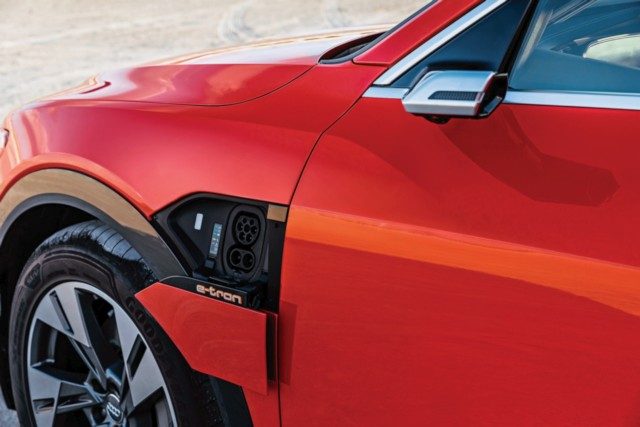
A three-phase asynchronous motor comprises two major parts: the outer, fixed stator, and the rotor contained therein. The stator is a sheet package consisting of thin, magnetically conductive electrical sheets. Inside, there are copper wire coils to which the three from the power electronics are connected. When a voltage is applied to them, a circumferential (rotating) magnetic field is produced. The stator’s rotating field induces a further magnetic field in the rotor — the rotor is carried along with the excitatory rotating magnetic field of the stator with a low rotational speed difference, that is, asynchronously. If the rotor turns more slowly than the rotating magnetic field, the electric motor in the car works as a traction motor. In the opposite case, it becomes a generator and converts kinetic energy into electrical energy. The asynchronous motors do not produce any electrically induced drag losses in de-energized condition, which makes them highly efficient. Not only are they very light due to the aluminium rotor, they also have further advantages: they require little maintenance and are particularly robust. Furthermore, no rare earth elements are used in the production of the electric motors.
Asynchronous motors can increase their output for a short period of time. The boost is available for a maximum of eight seconds. During this time, the output of the front electric motor increases from 125 to 135 kW (170 to 184 PS), while that of the rear motor increases from 140 to 165 kW (190 to 224 PS). This constitutes an overall increase by 13 per cent to 300 kW (408 PS) in total. The torque is also increased considerably by just over 18 per cent, from 561 to 664 Nm.
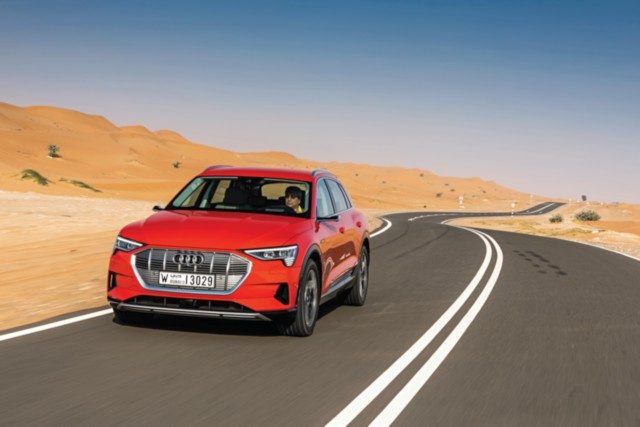
The Audi e-tron drive included some city driving, motorway, and up into the highest mountains in Abu Dhabi. As in a regular car, you press the start-stop button and select drive and you start rolling without a sound; the only thing you hear is the whine from the electric motor and the road noise from the tyres. The turn of foot is instant and, cruising on the highway effortlessly, the single-speed gearbox gives seamless power delivery. There is plenty of performance on tap and the car easily eclipsed 200 km/h.
In the mountain section the power from both the front and rear motors gives the Audi e-tron four-wheel traction and there is plenty of fun. Like a normal car, you can use the paddle shifter to use electrical braking in two stages.
We did a little bit of off-roading and the e-tron showed that it is capable of tackling the dirt without any problems. The display has two meters: one is the speedometer and the second shows how much power you are using while accelerating and the amount of energy you are recuperating while coasting and under braking. I would like to call it the power meter.
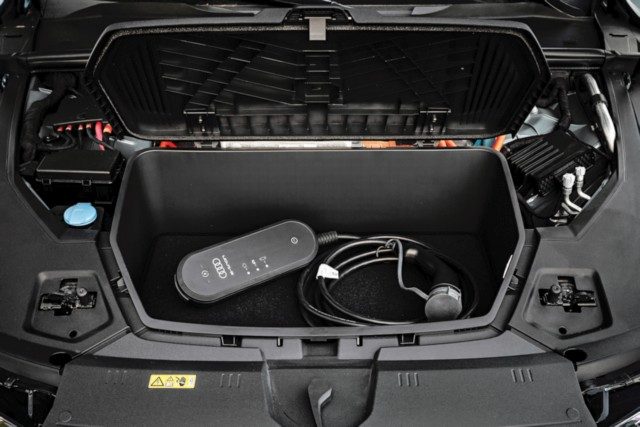
The claimed range on a full charge is 400 km under WLTP. During our drive the realistic range was between 270 and 280 km. The e-tron has all the fun-to-drive qualities without polluting the environment.
Need to Know – Audi e-tron 55 quattro
Price: £70,805 (Rs 64 lakh, approximately)
E-motors: Two, asynchronous, 135-kW front, 165-kW rear
Max Power: 408 PS (Boost mode)
Max Torque: 664 Nm (Boost mode)
Gearbox: Single-speed, direct drive
Kerb Weight: 2,490 kg
Performance:
0-100 km/h: 5.7 seconds (Boost mode)
Top Speed: 124 mph (200 km/h) (governed)
Range: 249 miles (400 km) (WLTP)
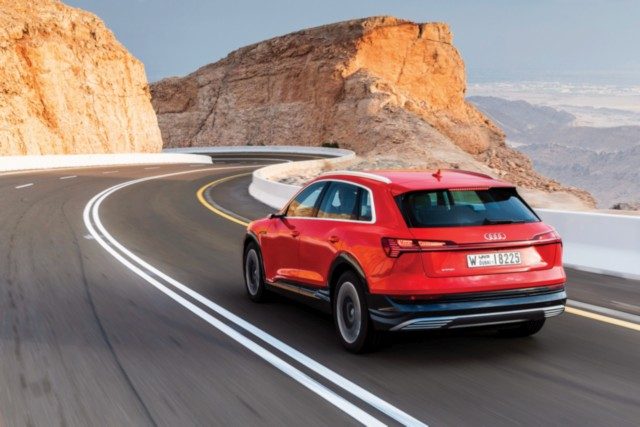




















Leave a Reply